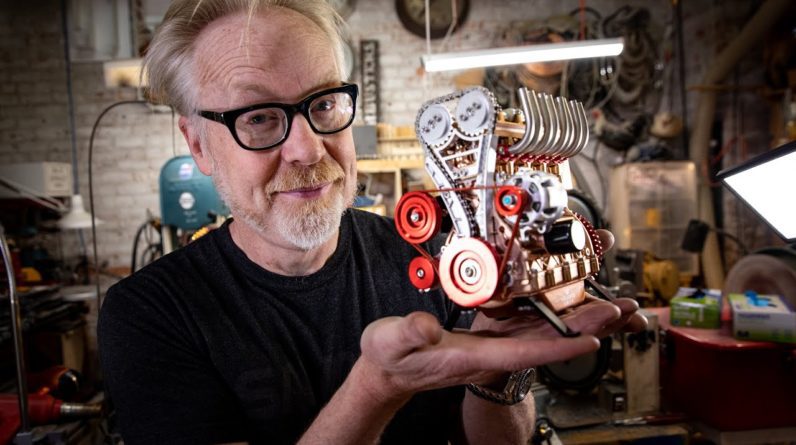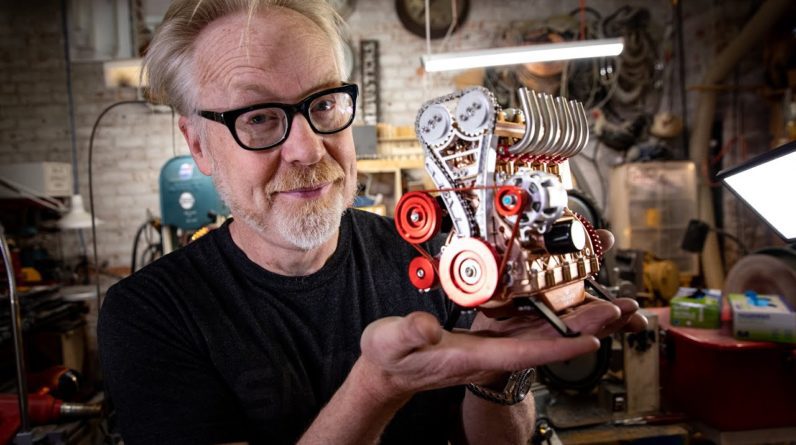– Instead of finishing a scale model with various types of metalized and silver paints in an effort to achieve the much sought after
natural metal finish, or, as it's known as NMF, (mellow music) metal foil presents a unique
and viable alternative. This video outlines some of the methods and techniques I have come
to find useful over the years while researching this elusive,
sometimes difficult finish. As with many modeling pursuits, there is probably much more to grow and expand upon these methods, and each modeler may find
variations on the theme to better suit their specific
project or abilities. The basics outlined here should suffice to get any intermediate
or above level modeler off to a good start on foil-based NMF.
As usual, practice will
greatly improve results, and use of alternative tools
and methods may be required for the specific needs of a given project. While foil does have some
superior characteristics to any form of paint
medium in certain areas, it cannot be used in extremely irregular and high-relief applications. For these cases, using a
mixed-media approach is recommended to appropriately blend the
finishes of foil with paints. In my experiences, one of the
most resilient NMF finishes achieved by paint is from
Alclad II applied over an appropriate base coat primer. So, without further ado, why
don't we get to the video! (fun rock music) (whooshing) (whooshing) (mellow music) Any brand of household
aluminum foil can be used. Sometimes the cheaper brands are better because they are thinner. Try several and see what you prefer. Other metal foils will work equally well. These include things like candy wrappers, gift wrap foils, and even
the really shiny mylars. However, the mylar will not bend to fit compound curves like metal foils.
Examine a foil to see what
finish you will get from it. Most foil has a dull and a shiny side, or a grain, and sometimes a texture. You can get variations in
the finish on the model by applying the adhesive
to the dull or shiny side, changing the orientation of a panel by rotating the foil, or using foil with a slightly different tone. The adhesive that I normally use is either Microscale or
Superscale foil adhesive. I have tried varnish, white glue, and Future floor wax as an adhesive, and they did not give good results. For me, the best method
to apply the adhesive is by a lint-free cloth
or a very soft brush. I have found that spray application causes the adhesive to bead on the foil, and that will show up as
bumps on your finished model. The goal is a very
smooth layer of adhesive.
If you can see ripples in
the glue when it is dry, you will see ripples in
your panel on the model. Try to flow the adhesive onto the foil. I pour a bit on the foil sheet and then spread it with
the brush or a cloth. Once you have selected
the foil you want to use, lay it out on a smooth, flat surface. A piece of glass or
plexiglass will work fine. Be sure it's as smooth as possible. The foil will pick up scratches, glue blobs, dirt, or any
other junk on the surface. Prepare only enough foil
for one work session. I usually work with a fairly small piece about eight inches by 10 inches or so. It is easier to handle that way. Use a lint-free rag to smooth
the foil out on the glass and then tape the corners or the edges. Now apply the adhesive by brushing or rubbing it on in one direction.
Then rotate the glass 90
degrees and apply a second coat. If you are going to be
working with compound curves or difficult angles, a third coat will improve the grab in the adhesive. Note that you don't want
to rub the undercoats with the brush or rag, as that
will make blobs in the glue. Be very gentle as you flow on later coats. When the glue has dried from a
milky appearance to a smooth, clear finish, you are
ready to cut and apply it. The adhesive works like contact cement. It will remain usable for several hours without losing it's tackiness. Cut the foil into slightly larger pieces than the panel on the model. Usually you will have a straightedge where you are butting up to a panel edge. Use a straightedge and cut
the foil from the sticky side. A pair of dividers can
help determine panel size, and a good straightedge is important. Don't lay the straightedge on the glue or it will adhere to it. A very sharp X-ACTO blade is important.
If the blade drags or
tears the foil, replace it. Cutting foil will dull the blade rapidly and the foil will then tear. You're now ready to begin
the foiling process. This works a lot like hanging wallpaper. Place your foil panel on the
model panel to be covered. Start on one edge or in the center and work toward the end
or to the outside edges. This helps to avoid wrinkles and tears. The point is to gently but firmly rub the foil down on the model.
Be patient and methodical. This is not something to
do when you are tired, angry, or distracted by something else. Use a tool to work the foil down smoothly. Remember, you are working with a very thin and malleable metal. It can be gently persuaded
and stretched a small amount to cover curves, rivets,
panel lines, et cetera. The tools I use are Q-tips, round toothpicks blunted with sandpaper, and flat toothpicks cut to a chisel edge. Round paintbrush ends can be useful, also. Sometimes very small wrinkles will appear. These can usually be worked out by continued gentle, firm rubbing. When you are working with compound curves, the foil will sometimes
begin to curl back on itself. You can make small
slits in the excess foil when this happens to relieve
the stress in the foil and enable it to curve better.
When the panel is fully covered, burnish all the edges down firmly. Work the foil down around the rivets into panel lines and into recesses. This is what really pops out the detail. Now, using your very sharp X-ACTO blade, trim the panel to the final shape. Use a straightedge, the
panel lines on the model, or whatever is convenient
as a guide for the blade. Carefully peel away the
excess, and that panel is done. Sometimes an edge will pop loose and will not burnish back down. A small drop of crazy glue
will help in that case. Before you begin to lay an adjacent panel, you need to clean up any excess glue that was left where you
peeled away the excess foil.
If you do not do this, it will
show under the next panel. I use a Q-tip dampened with
mineral spirits to do this. Work away from the panel so the liquid does not get under the
panel you just completed. Rubbing alcohol will also
work to remove excess glue. If you somehow have a thin sliver showing where two adjacent panels meet up, touches of silver paint will
usually work out just fine. If you really botch up a panel, tear it, find a big wrinkle
or some other disaster, just remove the panel, clean off the glue with alcohol or mineral spirits,
and put down a new panel. When you are working on
major join line areas, such as wings, or horizontal stabilizers, or other joints to major parts, work toward these joints from both sides and then trim the foil along the joint. This works better than attempting
to cover the join line. The join line usually involves a major change of direction for the foil, and that is difficult to do in one piece. When covering wings or other air foils, I recommend wrapping the foil over the leading edge whenever possible.
Wrap it over from the top
side and do some point on the lower surface where you can make a cut along a panel line. This makes a more solid connection of the foil to the model and reduces any problems with the foil
pulling away from handling it. It also puts the cut line
on the bottom of the model where any mistakes are less obvious. If you have a really
difficult area to cover, the lip of intake, the very front of an engine nacelle, or
a wing tip, for example, it's sometimes better to just paint it. Sometimes you can work
the foil in small sections to cover those really tight
curves, but usually paint will work out better in the
long run and will give you another texture or tone
to improve the model. Drop tanks would be another good example of something better painted than foiled. If your model has major painted parts such as ant-glare panels, de-icer boots, or major stripes, paint those first and then foil up to
them and trim the edges.
Foil will adhere to painted surfaces, but it will also show up any
imperfections in the paint, like grain, brush marks, et cetera. Foil does not take paint well at all, so attempting to put stripes or other markings over
the foil is difficult unless the other markings
can be done with decals. You will find that decals
adhere well to foil. However, they also tend
to reflect edges worse than on a painted surface. You may want to revert
to an older practice of trimming decals close to the design to reduce the clear area. This reduces the
possibility that the clear will be an eyesore on your finished model. I have not found that any of the decal setting
solutions affect the foil. So the small bits, like data plates, no step markings, et
cetera can be set well without major problems of trimming. You can use metal polish, such as Blue Magic, on your foiled model. However, remember that you may polish out the differences between
dull and shiny panels and wind up with a totally
polished model airplane.
You are working with metal, and it will do the same things as on
the full-sized object. You can use overcoats on the
foil, but it is not necessary. I would try it on a scrap of foil first. You would not want to spoil your finish if your flat coat or gloss
coat beaded on the foil. I sometimes use a coat of Future floor wax to seal the decals and
even out the surface. On a side note, foil also makes
an excellent masking medium. You can burnish it down around a curve; no need to worry about
minor wrinkles here. Trim the curve or mark your
need, and paint as usual. In most cases, when you remove the foil, you will find a sharper edge
than you can get with tape.
(energetic rock music).






